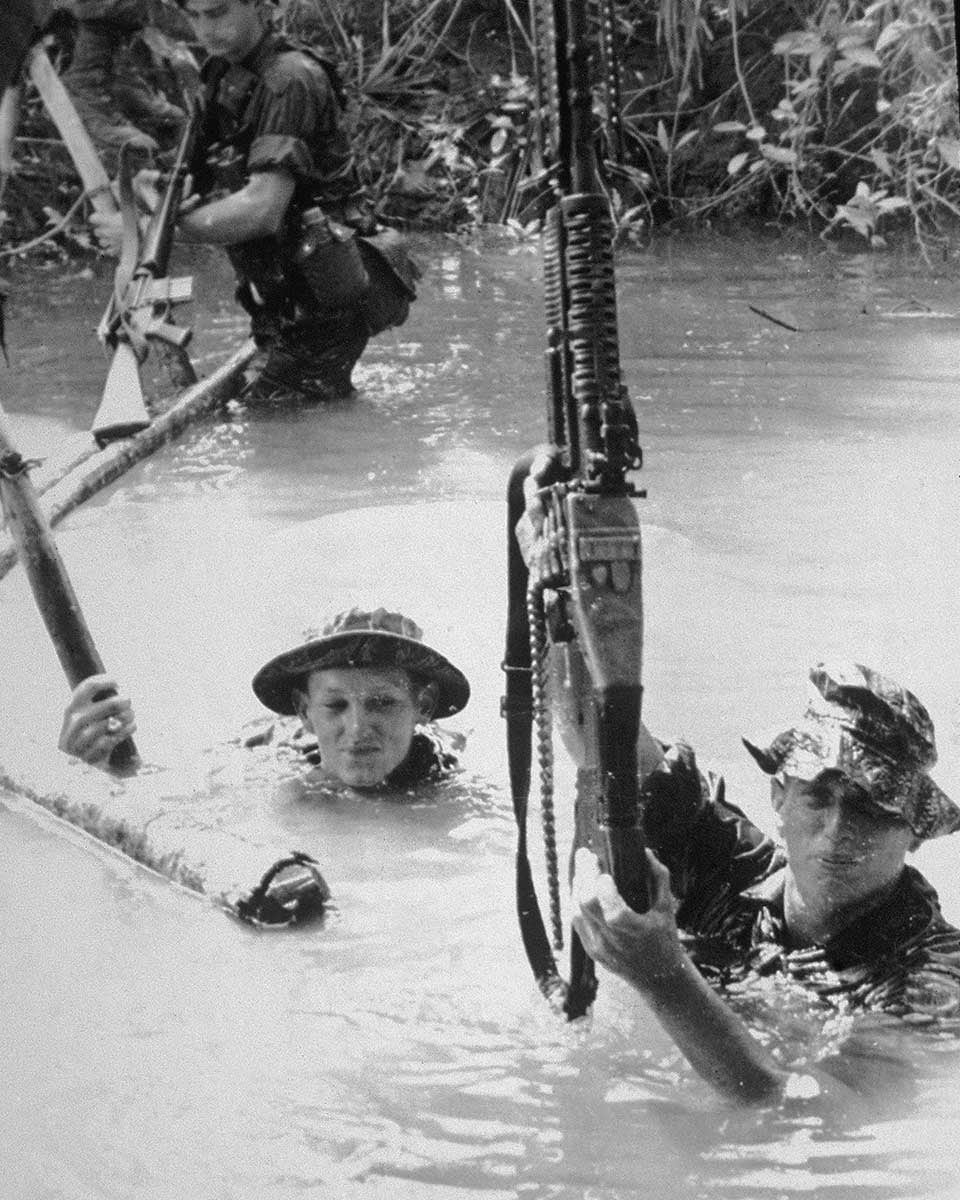Since the United States adopted the gas-operated .30-03-caliber Maxim Model 1904 gas-operated machine gun, that gun’s 62 pounds, combined with an 80-pound tripod mount, plus belts of ammunition and water for cooling, made it more of a form of mobile artillery than a useful source of close support for the infantry.
By the end of World War I, however, lighter automatic weapons, such as the M1917 Lewis and Chauchat machine guns, set an ongoing precedent for a practical means of backing up the rifleman with something both potent and readily available.
The end of that war saw the introduction of the M1918A2 Browning Automatic Rifle, which became the standard American squad weapon in World War II. On the other side, however, the Germans developed the machined MG 34 and stamped-metal MG 42 light machine guns, whose devastating rates of fire, made sustainable by changeable replacement barrels to avert overheating, set a new standard.
Read More: This is the Red Army’s version of the Squad Automatic Weapon
Read More: The real story behind the world’s first ‘assault rifle’
Read More: This submachine gun helped repel a Soviet invasion, then the Red Army built its own
A lighter weapon designed for the Fallschirmjäger (paratroops) employing a 20-round magazine equivalent to the BAR’s, the FG 42, was too late to see significant production, but it and its forebears left a profound impression on the Americans, who set about adapting elements from the German designs into a new squad machine gun of their own.
This led to a protracted process that ultimately led to the T161E3, which essentially amounted to an FG 42 designed to fire belt-fed ammunition like an MG 42. In February 1957 this was standardized for the U.S. military as the M60.
The M60 with integral folding bipod legs weighted 8 pounds less than the BAR and could be field stripped and reassembled in roughly half the time. It also offered the benefits of 100-round metallic-link belts of 7.62mm ammunition, which could be linked together to defend a fixed position.

The 600-round per minute rate of fire was less than half that of an MG 42 but was more economical on the ammo and a good gunner could manipulate the trigger to fire short, measured bursts or even aimed single shots—something the MG34 could, but the MG 42 could not do.
An M60 gunner in a defensive position had the option of using an M91 tripod, but a strong enough gunner could fire it from the shoulder, underarm or hip with relative ease.
The M60 got its acid test in Vietnam, where the guerrilla and light infantry ground operations carried out by the opposing sides tended to be dominated by automatic fire — both from the standard M16 and AK-47 assault weapons toted by the riflemen and the squad machine guns that backed them up.
Like the M16, the first M60s were vulnerable to dirt and fouling, in addition to which their first users found them heavy and awkward, leading to their being popularly(?) referred to as “pigs.”
Part of the initial problems lay in a widespread squad practice of giving the “pig” to a new — and comparatively expendable — arrival, rather than to someone with the physique, training or experience to get the best performance out of the gun.

That cold-blooded rationale was largely founded on the fact that the squad machine gun, whether an M60 or its RPD counterpart, tended to attract the most activity toward its elimination. By the time the M60E1 and M60E3 entered service in the 1960s, however, the type had evolved into an accurate, reliable weapon that could produce a murderous volume of fire wherever it was needed.
Well-chosen gunners proved to be an asset in firefights, ideally when assisted by an ammunition handler and a third teammate with extra barrels and ammunition. The ability to replace an overheated barrel proved advantageous in sustained firefights, since it allowed continuous fire as needed while an RPD-equipped enemy had to limit his bursts or wait for his barrel to cool down or risk it seizing up.
However much grunts may have bitched about the pig throughout the conflict, it became an invaluable asset that no squad could do without. It was also versatile enough to extend its benefits to M113 armored personnel carriers, helicopters and riverine craft on a variety of mountings.

The M60 remained an infantry mainstay until 1994, when testing began on a possible replacement. Although the gun’s latest variant, the M60E4, is arguably among the most mechanically perfect weapons of its kind, in 1997 the U.S. Army accepted the Belgian Fabrique Nationale-built MAG (Mitrailleuse d’Appui Général) 58 with its North Atlantic Treaty Organization-compatible 7.62x51 round, as its standard light machine gun.
Meanwhile, both NATO and the Warsaw Pact had been seeking lighter automatic weapons, which in NATO’s and the U.S. Army’s case in 1984 was the FN-produced M249 5.56mm SAW (squad automatic weapon, redesignated an LMG, or light machine gun, in 1994).
In spite of those general trends, M60s serve on with the U.S. Navy and U.S. Coast Guard, in addition to which numerous countries all over the world are still ordering M60s, especially M60E4s, from U.S. Ordnance Inc. in Reno, Nevada.
Although both LMGs are dependable, the M60E4 with its shortened barrel is easier for one soldier to use when dismounted than the M240, a trait recognized and preferred by many users.
Consequently, the “pig” is still in production and though its best days may lie behind it, they are far from over.




